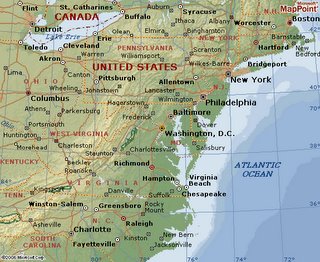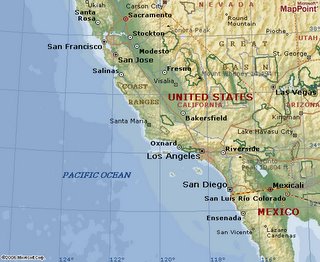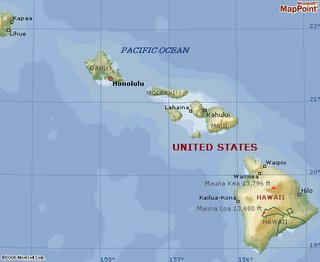Where Will You Be When the Floodwaters Rise?

*
Early this March, both ABC News and the Washington Post featured articles on global warming's accelerating meltdown of both Arctic and Antarctic icecaps (as seen here and here). While scientists have previously noted that a meltdown of Greenland's icecap would raise sea levels around the world by about 21 feet, a meltdown of Antarctica's icecap as well would lead to a worldwide increase in sea levels by about 200 feet.
In case you're wondering what a 200-foot rise in sea levels would amount to, please look at the attached maps. The darkest shade of green represents an elevation of 0 to 50 meters above sea level (a little over 164 feet). So in other words, take a look at that first rise in elevation and realize that high tide would be considerably higher than that. More importantly, a mere 20 foot increase would inundate most coastal cities and towns, destroying their economic viability and displacing vast populations (unless dramatic measures were taken, and probably even then).

So assume that without gigantic seawalls or other defenses, New York City, Boston, Los Angeles, etc all disappear beneath the waves or at best are reduced to a mere vestige of their former selves.
The Washington Post notes:
The Antarctic ice sheet is losing as much as 36 cubic miles of ice a year in a trend that scientists link to global warming, according to a new paper that provides the first evidence that the sheet's total mass is shrinking significantly.
The new findings, which are being published today in the journal Science, suggest that global sea level could rise substantially over the next several centuries.
It is one of a slew of scientific papers in recent weeks that have sought to gauge the impact of climate change on the world's oceans and lakes. Just last month two researchers reported that Greenland's glaciers are melting into the sea twice as fast as previously believed, and a separate paper in Science today predicts that by the end of this century lakes and streams on one-fourth of the African continent could be drying up because of higher temperatures.

ABC News adds:
Not to be pessimistic, but "just" losing most of our greatest cities over the next 30 years or so might qualify as an unmitigated disaster, in and of itself. To destroy that much economic power while rendering that many people homeless and jobless -- and probably hungry -- while also experiencing catastrophic climatic impacts on agriculture... this could result in aZwally explains that the ice shelves, which the Antarctic ice cap pushes out into the ocean, are responding more than they expected to Earth's warming air and water. If the melting speeds up to a rapid runaway process called a "collapse," coastal cities and villages could be in danger.
James Hansen, director of NASA's Earth Science Research, said that disaster could probably be avoided, but that it would require dramatically cutting emission outputs. If the proper actions aren't taken, Hansen said, the sea level could rise as much as 80 feet by the time today's children reach middle age.
"We now must choose between a serious problem that we can probably handle and, if we don't act soon, unmitigated disaster down the road," Hansen said.
 breakdown of law and order over vast territories, not to mention the deaths of many innocent human beings.
breakdown of law and order over vast territories, not to mention the deaths of many innocent human beings."Based on the history of the Earth, if we can keep the warming less than 2 degrees Fahrenheit, I think we can avoid disastrous ice sheet collapse," Hansen said.As some scientists have pointed out, the meltdown could progress far more rapidly -- not just if China and India burn considerably more fuel than they are now, but if the rapid rise in global temperatures triggers other environmental effects, such as the release of carbon from the
Hansen and other scientists point out that a rise of at least 1 degree Fahrenheit — and another few feet of sea level — seem virtually certain to happen because of the carbon that mankind has already put in the atmosphere.
 tundra or carbon and/or methane from the oceans. Depending on how quickly and significantly such events occur, we could have much worse concerns on our hands than losing a few hundred major cities.
tundra or carbon and/or methane from the oceans. Depending on how quickly and significantly such events occur, we could have much worse concerns on our hands than losing a few hundred major cities.But putting the most apocalyptic issues aside for the moment, why not ask yourself: Where will I be when the floodwaters rise?
Even if you're not sitting on the coastline of your country, remember, a "mere" 20 foot rise -- even over a period of several years -- will be wiping out coastal cities and communities and displacing at least a couple billion people worldwide. And most of those refugees will not have a second home in the Alps or the Rockies or the Himalayas or the Catskills. And if we see increased coastal storms and storm surges due to all of the excess heat in the atmosphere, living in the 20 to 200 feet of elevation may not be much fun even if sea levels stop with a Greenland meltdown.

And of course, a major ice sheet sliding off of either Greenland or Antarctica would create a tsunami that would dwarf the disaster we recently witnessed in South Asia. You're more apt to see a major collapse early on the process than later (when there's less ice to go sliding free), so 200 feet (plus storm surge levels) may be as high as your soon-to-be-local seashore may get. Comforting, isn't it?
So what are you going to do? I'll print some suggestions here soon as to what individuals and communities could do to deal with such a crisis. In the meantime I would simply suggest that you keep your eyes open... and pay attention to just where it is you live. If the oceans rise, you want to have made your plans before you have to start swimming.

If you would like to see some maps of potential sea levels for Britain and Ireland, Western Europe, Australia, New Zealand, China and the Koreas, India, Bangladesh and Pakistan, Indonesia, Japan and Canada, please follow the links in this sentence. And remember, some maps will look frightening, some maps will look comforting. But before deciding how well suited your country's geography happens to be for this transformation, take a look at where your greatest cities are located. If you're not a landlocked country, then odds are at least a few of them are on or near your coastline...
Soc
Future Imperative

0 Comments:
Post a Comment
<< Home